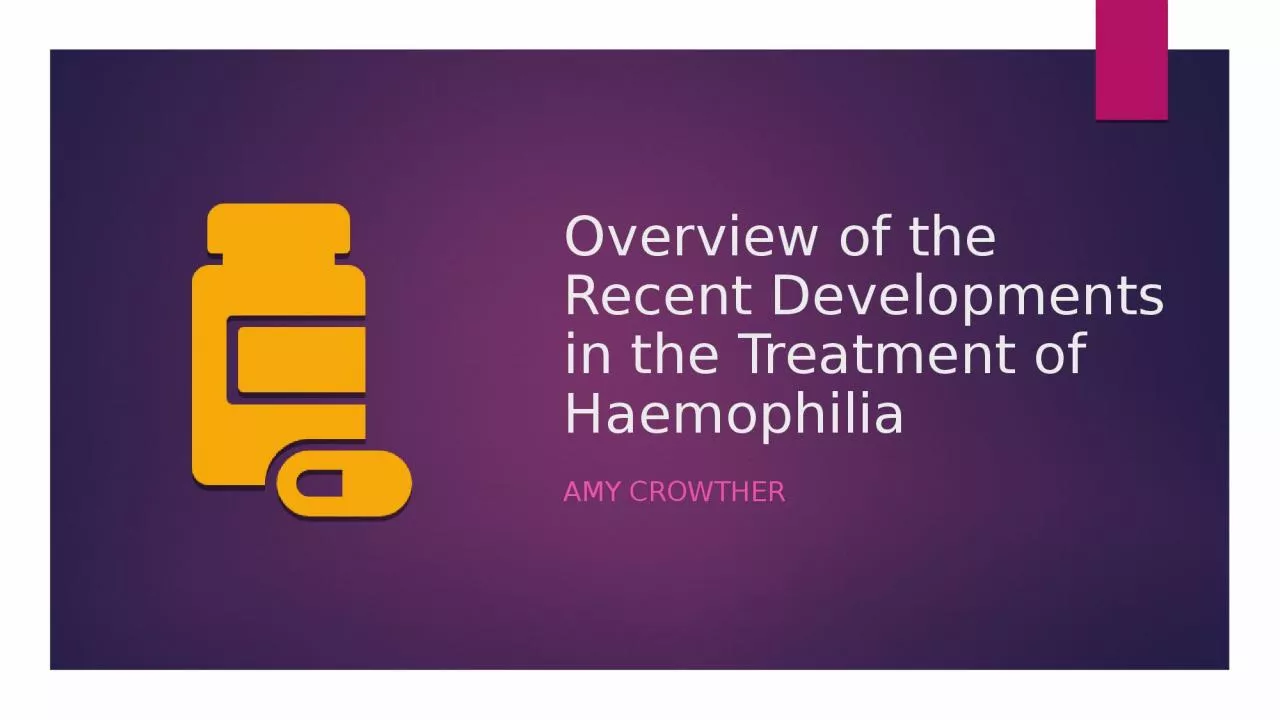

Amy Crowther What is Haemophilia Haemophilia is a coagulation disorder The responsibility of blood clotting is down clotting factors in the blood People with haemophilia have low levels of Factor VIII and Factor IX ID: 1037160
Download Presentation The PPT/PDF document "Overview of the Recent Developments in t..." is the property of its rightful owner. Permission is granted to download and print the materials on this web site for personal, non-commercial use only, and to display it on your personal computer provided you do not modify the materials and that you retain all copyright notices contained in the materials. By downloading content from our website, you accept the terms of this agreement.
1. Overview of the Recent Developments in the Treatment of HaemophiliaAmy Crowther
2. What is Haemophilia?Haemophilia is a coagulation disorder.The responsibility of blood clotting is down clotting factors in the blood. People with haemophilia have low levels of Factor VIII and Factor IX.Haemophilia A is associated with low levels of Factor VIII, which occurs in 1 in 5000 male births.Haemophilia B is associated with low levels of factor IX, which occurs in 1 in 50 000 male births.
3. Causes of HaemophiliaMost of the time haemophilia is inherited, this is congenital haemophilia.The genes for Factor VIII and IX are present on the X chromosome.Due to males only having one X chromosome then if that X chromosome is affected then he will have the disorder, making it more common in males.There is also another kind of haemophilia, this is known as Acquired Haemophilia.This can develop when a person develops autoantibodies that attack their clotting factors, it is usually Factor VIII.
4. Symptoms of HaemophiliaSymptoms for Haemophilia A and B are the same.People with haemophilia tend to experience a range of bleeding symptoms.This can be anything from bleeding in the brain or stomach or bruising easily.
5. Treatments
6. Standard TreatmentsRecombinant factor VIII and IX.Does not come from human plasma – genetically engineered.Used to prevent joint bleeding and the deterioration of joints.
7. Musculoskeletal TreatmentNearly ¾ of all haemorrhages with haemophilia occur in the musculoskeletal systemAround 15-20% of patients will develop an inhibitor antibody that prevents the recombinant clotting factor from clotting blood.Physiotherapy and rehabilitation are highly important in joints returning to their normal state of motion and improving quality of life.The physiotherapy and rehab treatment can be divided into the following categories which target:Muscular haematomas – tend to occur due to direct contusion.Hemarthrosis – can develop quickly and cause inflamed, warm joint and a limited range of motion.Rehabilitation after surgery.
8. AAV Gene TransferAn AAV (adeno-associated virus) gene transfer is an in vivo gene therapy.A modified AAV vector containing a therapeutic gene would be injected on a one-time occasion intravenously.The capsid of the AAV vector helps to transport the therapeutic gene to the cell of interest for protein production.For haemophilia, serotype 2, 8 and 5 are the most common used for haemophilia due to their specific modifications.The factor VIII gene has the construction to fit in the small space of the AAV vector.
9. AAV Serotype 2
10. Tranexamic Acid (TXA)Normally used for heavy menstrual bleeding but is also approved for short-term prevention for patients with haemophilia, such as after tooth extraction.TXA is a reversible competitive inhibitor to the lysine receptor, which is found on plasminogen. When the TXA receptor binds it prevents plasmin from binding and dissolving fibrin clots.
11. Rebalancing TherapyTargets natural anticoagulant pathways to restore haemostatic equilibrium.Fitusiran is an RNA interference therapy which can be used to target antithrombin in the liver and interferes with antithrombin translation to prevent antithrombin synthesis.
12. Inhibiting Protein C Activated Protein C (APC) is an anticoagulant that degraded factors VIII and IX.Using mAb’s is a way of inhibiting APC, it works by targeting APC and interferes with the inactivation of Factors VIII and IX.Studies done, in vitro (studies that are performed with in microorganisms outside their biological context), show as shortened activated partial thromboplastin time (aPTT).
13. Ethics of Previous TreatmentsBlood screening was not introduced until 1992.Between 1970 and 1990 an estimated 3000 people died due to blood-borne infections from transfusions.In the UK there was a high demand for Factor VIII, so it was imported from the US. At the time, a lot of this blood was from prison inmates and drug-users who had a higher proportion of blood-borne diseases, such as HIV and hepatitis.Unfortunately, during this period harm was being caused to patients which goes against one of the pillars of medical ethics, non-maleficence.However, at the time doctors were trying to do what was best for the patient, but weren’t fully aware about the blood-borne infections due to the lack of screening
14. Conclusion The main aim of these treatments is to provide a better quality of life for patients with haemophilia.By doing this you are adhering to one of the five pillars of medical ethics, beneficence.